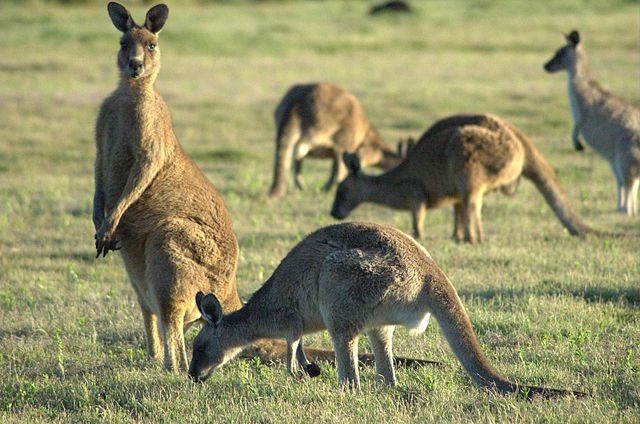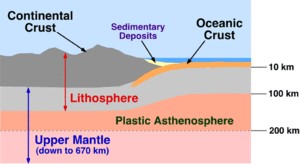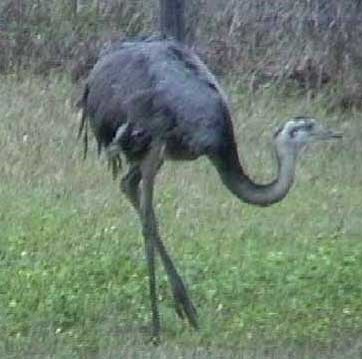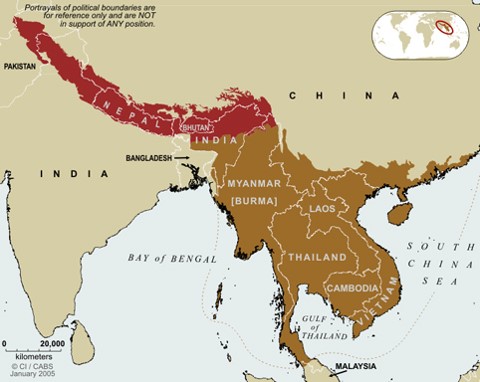3.2 Plate Tectonics, Evolution and Biogeography
 Plate Tectonics and Evolution
Plate Tectonics and Evolution
I find this topic really interesting and I usually teach this section as an old fashioned lecture with additional media. This means we can get through all the material in one hour but there are lots of activities that you can supplement this with if you wish, for example plotting the position of volcanoes and earthquakes to show the location of plate boundaries. Using play dough to model plate boundaries is fun but this knowledge is now beyond the syllabus requirements.
The material on this page with all the videos is not possible to cover in a one hour lesson but by picking and choosing the videos, you can, just about, cover the content, without activities, in one hour.
Significant Ideas:
- Environmental change gives new challenges to species, which drives the evolution of diversity.
Recommended Teaching Time (not including practicals): 3 hours (for sub-topic 3.2)
From the Guide (IB ESS Guide 2015)
- Isolation of populations can be caused by environmental changes forming barriers such as mountain formation, changes in rivers, sea level change, climatic change or plate movements. The surface of the Earth is divided into crustal, tectonic plates that have moved throughout geological time. This has led to the creation of both land bridges and physical barriers with evolutionary consequences.
- The distribution of continents has also caused climatic variations and variation in food supply, both contributing to evolution.
 Structure of Earth
Structure of Earth
You can think of the Earth like an onion with layers.
The outer layer of the Earth is solid but the inner layers are viscous (thick and sticky).
Studies, using seismic waves, remote sensing and magnetic field variations have elucidated information about the earth's structure.
There was a fascinating BBC Horizon documentary, The Core, which showed how scientists had studied the structure of the earth without being able to enter very deep into the structure due to the extreme temperatures and pressure.
 Plates Float on the Aesthenosphere
Plates Float on the Aesthenosphere
Plates are rigid blocks of the earth’s crust, which float on the aesthenosphere. They can be continental crust, oceanic crust or a mixture of both. An example is the Pacific Plate which is almost entirely oceanic crust. Continental plates are lighter and less dense than oceanic plates.
Plate boundaries can be constructive or destructive and convergent, divergent or transforming. Plate boundaries are associated with volcanoes and earthquakes.
 How do plates move?
How do plates move?
Convection currents / cells in the asthenosphere drive plate tectonics. We learned about convection cells in 2.4 Biomes, Zonation and Succession along with biomes and atmospheric convection cells.
Hot magma rises, cools and circulates carrying plates along with it.
Plumes are columns of molten rock that rise from places deep in the mantle called hot spots. Sometimes a plume can melt a hole and form a volcano e.g. Haiwaii. In fact the series of islands in Hawaii has been formed by one plume staying in one place and the pacific plate moving across it.
This short video (about 1.5 minutes) gives a good animation of these convection cells leading to plate tectonics.
.jpg) Continental Drift
Continental Drift
Alfred Wegener suggested that all of the continents were originally joined together as a super-continent, Pangaea.
Continental Drift explains that this continent broke up and moved apart to form the current continents. The northern part of Pangaea became Laurasia, breaking up to form North America, Greenland, Europe and Asia. The southern part, Gondwanaland, became South America, Africa, Australia and Antartica.
The Mediterranean Sea is a remnant of the Tethys Sea which separated these two super-continents.
Here's a short video (7.5 mins) about the life of Alfred Wegener and Pangaea. It's a great demonstration of how scientists work, revisiting and revising their work.
HHMI Biointeractive has a short animation (1m 16s) of plate tectonics and continental drift.
Break up of the Super Continent Pangaea
During this animation of the breakup of Pangaea, watch out for India as it has an interesting past!
If you want to learn more about Plate Tectonics, I highly recommend the BBC documentary series Rise of the Continents. There's not much available legally online but here's a fun clip about the Himalayas (about 3 min 20 sec).
Evidence for Continental Drift
There are many sources of evidence. Here are some nice examples.
 Palaeontology
Palaeontology
Fossils of similar plant & animal species found on both sides of oceans with fossils of tropical species found in areas with cold climates now.
Notice in the image how Glossopteris, an extinct fern, has fossil remnants in South America, Africa, India, Australia, and Antarctica.
Geomorphology
Coastlines on opposite sides of the oceans appear to fit together and there are glacial landforms found in areas which now are tropical.
![By Julsep 6 - http://neic.usgs.gov/neis/qed/, Public Domain, https://commons.wikimedia.org/w/index.php?curid=10411746]() Geology
Geology
Rock deposits are similar in areas separated by oceans. There are coal deposits in Antartica (an indication of tropical forests during the Cretaceous Period). Glacial deposits are widespread in Australia, South America, S Africa, and India - areas far from areas under the last ice age.
It is rare to find active volcanoes & earthquakes in the middle of large continents and you can map the locations of earthquakes and volcanoes to see the location of the plates.
.jpg) Biogeography
Biogeography
Alfred Russel Wallace, a contemporary of Darwin, worked extensively in Indonesia and noted the differences in the biota allied to Australia or Malaysia and devised a dividing line – the theory being that two different sets of organisms converged in Indonesia.
If you are in Bali, you will find species much more similar to those in Malaysia (from Laurasia), while if you are in Lombok, you will find species much more similar to those in Australia (from Gondwanaland).
Here's a short video (7 min 44 sec) about the life of Wallace from HHMI.
 Disjunct Species
Disjunct Species
Other evidence in biogeography comes from disjunct species. These are “sister” species that are far apart geographically, separated by the moving continents. They have a common ancestor which existed before the continents split apart. For example, the Monkey Puzzle Tree is present in Chile and New Zealand.
The map shows the distribution of Sequoias and Metasequoias – sister genera. (These are the giant redwoods).
 A More Tropical World
A More Tropical World
Originally the plates were located more centrally, around the equator in the great continent of Pangaea.
The Earth at this time was generally warmer and the climate of the land masses was consequently more tropical.
Organisms could move between what would now be separate continents, quite freely.
This video (6.5 mins) shows how the continents have changed distribution from being centred largely over the equator to distributed from pole to pole over the last 540 million years.
 Evolution and Biogeography
Evolution and Biogeography
When organisms move, the populations mix, interbreed, and so do their genes, making a homogeneous gene pool.
These freely interbreeding, mixing organisms were the ancestors of our current species.
As the plates started to drift apart, the bridges that allowed these species to interbreed and mix were broken; now organisms were separated into different populations, isolated from each other.
This separation meant that the organism’s gene pools were no longer mixing and the allowed the separated and isolated populations to evolve independently, leading to divergent evolution.
I've created a short video from an old powerpoint I had to talk through these concepts with a simple animation.
Evolution of Ratites
 |  |  |  |
| Emu from Australia | Ostrich from South Africa | Rhea from Brazil | Kiwi from New Zealand |
All these birds are in a group called the Ratites. Ratites all had a common ancestor that was present in Gondwanaland, the southern supercontinent. When Gondwanaland separated, the population of ratites that were present in Australia evolved into the Emu, in New Zealand - there was the Moa (now extinct), Elephant Birds (now extinct) and the emblem of New Zealand, the Kiwi. In Papua New Guinea you will find the Cassowary, in Africa there is the Ostrich and in South America, the Rhea. From one common ancestor this divergence led to an increase in biodiversity and all these bird species.
Evolution of Mammals in Australia
 |  |  |
| Kangaroos | Duck Billed Platypus | Echidna |
Before Gondwanaland separated there was a common ancestor to the mammals but Australia separated before the more modern mammals we know today had evolved. Therefore, in Australia you have two ancient lineages of mammals, the marsupials and monotremes but no modern mammals. The marsupials produce embryo like offspring which crawl into a pouch, feed off rich milk, and develop until they are big enough to leave the pouch. Monotremes still lay eggs but they do produce a milky substance to feed their offspring.
 No Mammals in New Zealand
No Mammals in New Zealand
When New Zealand broke away from Gondwanaland, there was no common ancestor of mammals in the land mass. This means that there are now no native land-living mammals in New Zealand, only bats which must have arrived more recently by air.
The niches that are held by mammals in other land masses, are held by the diversification (adaptive radiation) of birds.
 Climate Change Increases Diversity
Climate Change Increases Diversity
As the plates drifted apart and further from the equator, their climates also diverged creating more distinctive climates. The Antarctic once had a subtropical climate with rainforests (there are coal deposits under the ice). This increase in diversity of climates increased the diversity of habitats and thus increased biodiversity.
 Colliding Plates - Increased Biodiversity
Colliding Plates - Increased Biodiversity
During continental drift some plates collided. This brought two separated sets of organisms together, creating opportunities for the new mixing of gene pools and thus evolution of new species.
The Indian plate collided with the Eurasian plate creating the Himalayas. At the same time, North Africa and Arabia moved closer to Eurasia. This created the possibility for migration and mixing of organisms from 3 different land masses.
The Himalayas are now one of the worlds’ biodiversity hotspots mixing of gene pools. Adaptive radiation was able to occur in the increased diversity of habitats created by the mountain building process.
 Marine Environments Changed
Marine Environments Changed
Continental drift also separated or merged marine environments. The same processes of isolation or mixing of gene pools of organisms occurred and biodiversity was able to increase.
The formation of the Isthmus of Panama and the separation of the Tethys Sea at the equator and the creation of the Atlantic and Pacific Oceans led to the mixing of oceanic biota around the modern Cape Horn (Tierra del Fuego) and the isolation of biota at the equator and in the Mediterranean Sea.
.jpg) Loss of Biodiversity in South America
Loss of Biodiversity in South America
North America was part of the northern landmass Laurasia wjhile South America was part of Gondwanaland. When the two continents were joined by the land bridge of Central America (the isthmus of Panama) the separate communities of mammals were able to mix. This led to the giant mammal species of South America becoming extinct, leading to a loss of biodiversity.
![]() Plate Margins Can Create New Land
Plate Margins Can Create New Land
Constructive plate margins create new land and therefore new habitats, e.g. Himalayas.
Volcanic activity at the subduction zones also creates new land.
Volcanic islands, such as the Hawaiian archipelago or the Galapagos Islands have created numerous new habitats which are then colonised and go through a process of succession.
This allows for the possibility of adaptive radiation and a massive increase in biodiversity.
 Adaptive Radiation
Adaptive Radiation
Some islands have a vast array of closely related species which have radiated out to fill the many empty niches that are newly created.
This often happens because the islands are young and volcanic in origin or isolated for a very long time and therefore the ancestral species took a different evolutionary pathway.
An example of the first scenario is the adaptive radiation of honeycreepers in Hawaii or Darwin’s finches on the Galapagos Islands.
 Biodiversity Hotspots
Biodiversity Hotspots
New Zealand, the Himalayas, Hawaii, the Galapagos Islands are world biodiversity hotspots.
A biodiversity hotspot is a biogeographic region that is both a significant reservoir of biodiversity and is threatened with destruction. The term biodiversity hotspot specifically refers to 25 biologically rich areas around the world that have lost at least 70 percent of their original habitat.[1]
It seems that endemic species on islands are particularly prone to threats from invasive non-native species. See Invasive Species
The theory of island biogeography looks at the relationship between biodiversity and size of the new islands.
Student Task
Test yourself...
1. Explain how plate tectonics has led to the evolution of biodiversity.
2. Deep time
Footnotes
- ^ https://www.sciencedaily.com/terms/biodiversity_hotspot.htm
